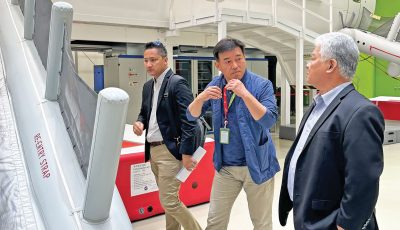Tasi tours
I had always been partial to Tasi Tours, more so when I learned that the impressive apartment complex going up at the corner of Beach Road and Sugar Dock wharf is a Tasi project.
I once was at the south Garapan compound where the tour buses are located along with the office that sells tickets to Mañagaha. I brought my wife, stepson, and a guest to the island off the lagoon a few months back so I was led to purchase the tickets at the “local” resident’s window at reduced price.
A partner in a Language Studio in Shenyang, Liaoning and I have packaged a language immersion tour on Saipan; Chinese learners join an ecologically friendly tour of the island as well as get to speak English on a “hear, repeat” method. Since English is a phonetic language, we want the learners to train their ears to hear the language spoken at the closest English speaking place rather than the customary academic recognition of words that comes from learning characters (Hanzi) the Chinese way.
The tour part intentionally relies on existing businesses. We patronize established commercial concerns that provide transport, accommodations and meals, and my associates handle the contact with human resource. As a former schoolteacher, my specialty is pedagogy, how people learn from experience, retain and remember what they learn by putting up signs and symbols, words and numbers as handles, and teach what they learned to others in the style of discourse known to both sides. It’s a stone thrown into the middle of a pool causing ripples of waves, an appropriate analogy.
The dependence on existing local businesses came when in the discussion on whether to bring in a Shanxi photographer with his whole set of digital cameras to do wedding pictures was discouraged until I found out how saturated photography-taking business was on island. To be sure, wedding pictures are a big item among Chinese tourists for the “face” it provides when the copies are prominently displayed on walls in the homes, but the practice has deteriorated to just the level of rented attire.
I recently attended a workshop at one of the resort hotels and what was a serene chapel where weddings were held once was turned into a function room, seemingly uncared for as a decorative panel came down while we conducted the workshop. Now, wedding photos are taken for the back home decor without the ceremony.
When still a cleric on island, I refused to perform weddings at hotel chapels for the fee and the photo ops without ensuring that the couple are versed in the implications of the covenant of marriage, to affirm what they already are into anyway—the decision to live together as one unit. The white gown and the tux do not a marriage make; saying and hearing of “I do” does!
Not too long ago, I wrote of manners. I would not mind instructing Tasi personnel on phone etiquette. I called on a Friday thinking of bringing my guest to Mañagaha but I was not sure what tickets to buy. I was an island resident, so were two Chinese nationals, a contract worker (CW), and another waiting for USCIS response to his change of status as a recipient of an approved immigrant status. The third was my China guest.
“Sorry but the office for ‘locals’ is closed at 3pm,” the voice said. It was a quarter of the hour past 5pm. “But you can come and get tourist tickets at $43 each.”
I said I was a local, and two in my party qualified for the local price of $24.
“I am sorry, the office for ‘local’ is closed,” the voice repeated. We were not getting anywhere.
Noticing the accent, I asked if the lady was Korean. “I am Japanese. There are no Koreans here,” she replied. Ooops. Wakarimasu.
“OK, I want to catch the 9:40am ferry to Mañagaha. Can I buy the tickets at the wharf? Tell me what to do,” I pleaded.
“You can come to the office now and buy the tickets. They are $43 each,” she repeated.
A tropical depression threatened in the south, and my China guest snorkeled enough in the lagoon to last him a lifetime, so the timing was possibly not propitious. Besides, he liked Saipan so much he vowed to bring his immediate family (papa, stepmother and half-sister) on the next trip.
I’ve done the Shinkansen on two occasions, once from Tokyo to Osaka, and the other from Narita to Sapporo on Hokkaido. Transiting in Narita and overnighting close to the airport was taken for granted when traveling from North America to Asia and vice versa. I relished looking down on the scenery coming from Manila or Saipan, and return. Doing Nagasaki, home to a faculty member at Shenyang Aerospace U, is in my to-do list; the land of the rising sun is more than transit point.
I called Tasi Tours hoping for clearer instructions to make the morning ferry and got a second Japanese lady. She was more haughty than the first. So I skipped Mañagaha altogether, keeping it on the list for my colleague’s next visit.
Funny. Manners. Even on the phone. It matters. Our Nihonggo sisters could use a few lessons.



























